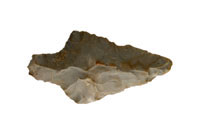Caught knapping – shaping flint

Flint knapping is a method of shaping flint – a type of hard mineral quartz – by striking it repetitively to knock off flakes. Flint knapping can be used to produce stones for construction work or decoration. However, it was originally used to create tools and weapons. The word ‘flint knapping’ derives from the Dutch word ‘to knock’ and the process dates back to the Stone Age.
During the Stone Age flint was worked to create arrowheads for hunting and warfare. Flint-headed arrows were used to hunt deer and wild cattle at a range of about 20 metres. These wounded the animals rather than killing them instantly, and the hunters would follow the trail of blood until they caught up with the exhausted animal and finished it off. In times of war, flint arrows could travel as far as 200 metres.
Flint knappers use pieces of stone, wood, bone or antler to chip off flakes of flint, creating flat-faced stones with multiple uses. Anyone can have a go at flint knapping, but it can be dangerous as it involves razor-sharp stone and dust so it’s important to wear gloves and goggles and to supervise children carefully. It can, however, be a wonderful way to recreate a bit of ancient history in a woodland if you live in an area where there are flints.
If you are interested in learning more, there are various courses to teach flint-knapping in woodlands around the country. One such course is Will Lord's course in Kent . The website address is: www.natural-pathways.co.uk/flint-knapping.php . You can even buy a gift voucher – an unusual birthday present perhaps?
One very expert flint knapper is Allan Course, who replicates Stone Age tools and weapons in order to understand more about the past. Allan runs flint-knapping courses in the spring and summer, which he holds outdoors at a friend’s farm in Sussex. You can read more about him at http://guswatson.com/stoneage.html .
You can also watch Phil Harding creating an axe head with flint knapping techniques here:
Comments are closed for this post.
